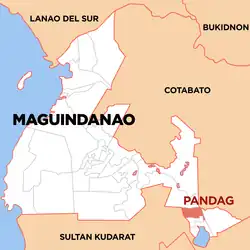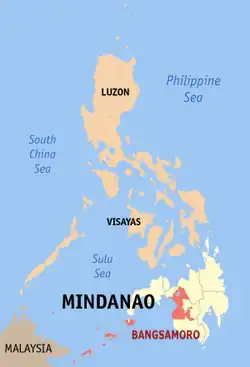Pandag
Pandag | |
|---|---|
| Municipality of Pandag | |
 Municipal Compound and Hall | |
 Flag  Seal | |
 Map of Maguindanao del Sur with Pandag highlighted | |
.svg.png) Pandag Location within the Philippines | |
| Coordinates: 6°44′28″N 124°46′58″E / 6.741053°N 124.782714°E | |
| Country | Philippines |
| Region | Bangsamoro Autonomous Region in Muslim Mindanao |
| Province | Maguindanao del Sur |
| District | Lone district |
| Founded | December 30, 2006 |
| Barangays | 8 (see Barangays) |
| Government | |
| • Type | Sangguniang Bayan |
| • Mayor | Mohajeran "Odjie" Balayman |
| • Vice Mayor | Sanny S. Macalintangui |
| • Representative | Mohamad P. Paglas Sr. |
| • Municipal Council | Members |
| • Electorate | 16,226 voters (2025) |
| Area | |
• Total | 85.31 km2 (32.94 sq mi) |
| Elevation | 18 m (59 ft) |
| Highest elevation | 38 m (125 ft) |
| Lowest elevation | 7 m (23 ft) |
| Population (2024 census)[3] | |
• Total | 31,329 |
| • Density | 370/km2 (950/sq mi) |
| • Households | 4,146 |
| Economy | |
| • Poverty incidence | 48.44 |
| • Revenue | ₱ 257.2 million (2022) |
| • Assets | ₱ 224 million (2022) |
| • Expenditure | ₱ 116.1 million (2022) |
| • Liabilities | ₱ 45.2 million (2022) |
| Service provider | |
| • Electricity | Maguindanao Electric Cooperative (MAGELCO) |
| Time zone | UTC+8 (PST) |
| ZIP code | 9616 |
| PSGC | |
| IDD : area code | +63 (0)64 |
| Native languages | Maguindanao Tagalog |
Pandag, officially the Municipality of Pandag (Maguindanaon: Ingud nu Pandag; Iranun: Inged a Pandag; Tagalog: Bayan ng Pandag), is a municipality in the province of Maguindanao del Sur, Philippines. According to the 2020 census, it has a population of 26,356 people.[5]
It was created out of 8 barangays of Buluan, Maguindanao, by virtue of Muslim Mindanao Autonomy Act No. 203,[6] which was subsequently ratified in a plebiscite held on December 30, 2006.
Geography
Barangays
Pandag is politically subdivided into 8 barangays. Each barangay consists of puroks while some have sitios.
- Kabuling
- Kayaga
- Kayupo (Cuyapo)
- Lepak
- Lower Dilag
- Malangit
- Pandag
- Upper D’lag
Climate
| Climate data for Pandag | |||||||||||||
|---|---|---|---|---|---|---|---|---|---|---|---|---|---|
| Month | Jan | Feb | Mar | Apr | May | Jun | Jul | Aug | Sep | Oct | Nov | Dec | Year |
| Mean daily maximum °C (°F) | 31 (88) |
31 (88) |
32 (90) |
32 (90) |
31 (88) |
30 (86) |
30 (86) |
30 (86) |
30 (86) |
30 (86) |
30 (86) |
31 (88) |
31 (87) |
| Mean daily minimum °C (°F) | 23 (73) |
23 (73) |
23 (73) |
24 (75) |
24 (75) |
24 (75) |
24 (75) |
24 (75) |
24 (75) |
24 (75) |
24 (75) |
24 (75) |
24 (75) |
| Average precipitation mm (inches) | 64 (2.5) |
45 (1.8) |
59 (2.3) |
71 (2.8) |
140 (5.5) |
179 (7.0) |
192 (7.6) |
198 (7.8) |
163 (6.4) |
147 (5.8) |
113 (4.4) |
66 (2.6) |
1,437 (56.5) |
| Average rainy days | 12.2 | 10.3 | 12.7 | 15.7 | 26.0 | 27.4 | 28.1 | 28.2 | 26.0 | 26.7 | 22.9 | 16.6 | 252.8 |
| Source: Meteoblue (modeled/calculated data, not measured locally)[7] | |||||||||||||
Demographics
| Year | Pop. | ±% p.a. |
|---|---|---|
| 2007 | 20,557 | — |
| 2010 | 13,795 | −13.51% |
| 2015 | 25,057 | +12.04% |
| 2020 | 26,356 | +1.07% |
| 2024 | 31,329 | +4.24% |
| Source: Philippine Statistics Authority[8][9][10][11][12] | ||
Economy
Poverty Incidence of Pandag
10
20
30
40
50
60
70
80
2006
61.60 2009
66.77 2012
70.22 2015
61.14 2018
70.18 2021
48.44 Source: Philippine Statistics Authority[13][14][15][16][17][18][19][20] |
Notes
References
- ^ Municipality of Pandag | (DILG)
- ^ "2015 Census of Population, Report No. 3 – Population, Land Area, and Population Density" (PDF). Philippine Statistics Authority. Quezon City, Philippines. August 2016. ISSN 0117-1453. Archived (PDF) from the original on May 25, 2021. Retrieved July 16, 2021.
- ^ "2024 Census of Population (POPCEN) Population Counts Declared Official by the President". Philippine Statistics Authority. 17 July 2025. Retrieved 18 July 2025.
- ^ "PSA Releases the 2021 City and Municipal Level Poverty Estimates". Philippine Statistics Authority. 2 April 2024. Retrieved 28 April 2024.
- ^ "2024 Census of Population (POPCEN) Population Counts Declared Official by the President". Philippine Statistics Authority. 17 July 2025. Retrieved 18 July 2025.
- ^ "Muslim Mindanao Autonomy Act No. 203; An Act Creating Municipality of Pandag in the Province of Maguindanao, Providing Funds Therefor, and for Other Purposes" (PDF). Regional Legislative Assembly, Autonomous Region in Muslim Mindanao. Retrieved 27 January 2016.
- ^ "Pandag, Maguindanao : Average Temperatures and Rainfall". Meteoblue. Retrieved 19 January 2019.
- ^ "2024 Census of Population (POPCEN) Population Counts Declared Official by the President". Philippine Statistics Authority. 17 July 2025. Retrieved 18 July 2025.
- ^ Census of Population (2015). Highlights of the Philippine Population 2015 Census of Population. Philippine Statistics Authority. Retrieved 20 June 2016.
- ^ Census of Population and Housing (2010). Population and Annual Growth Rates for The Philippines and Its Regions, Provinces, and Highly Urbanized Cities (PDF). National Statistics Office. Retrieved 29 June 2016.
- ^ Censuses of Population (1903–2007). Table 1. Population Enumerated in Various Censuses by Region: 1903 to 2007. National Statistics Office.
- ^ "Province of". Municipality Population Data. Local Water Utilities Administration Research Division. Retrieved 17 December 2016.
- ^ "Poverty incidence (PI):". Philippine Statistics Authority. Retrieved December 28, 2020.
- ^
- ^
- ^ "City and Municipal Level Poverty Estimates; 2006 and 2009" (PDF). Philippine Statistics Authority. 3 August 2012.
- ^ "2012 Municipal and City Level Poverty Estimates" (PDF). Philippine Statistics Authority. 31 May 2016.
- ^ "Municipal and City Level Small Area Poverty Estimates; 2009, 2012 and 2015". Philippine Statistics Authority. 10 July 2019.
- ^ "PSA Releases the 2018 Municipal and City Level Poverty Estimates". Philippine Statistics Authority. 15 December 2021. Retrieved 22 January 2022.
- ^ "PSA Releases the 2021 City and Municipal Level Poverty Estimates". Philippine Statistics Authority. 2 April 2024. Retrieved 28 April 2024.
External links
- Pandag Profile at the DTI Cities and Municipalities Competitive Index
- MMA Act No. 203 : An Act Creating Municipality of Pandag in the Province of Maguindanao Archived 2014-02-26 at the Wayback Machine
- Newly created provinces, municipalities, barangays, converted city Accessed on March 9, 2006.
- Philippine Standard Geographic Code
- Philippine Census Information
- Local Governance Performance Management System
